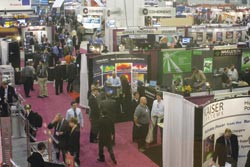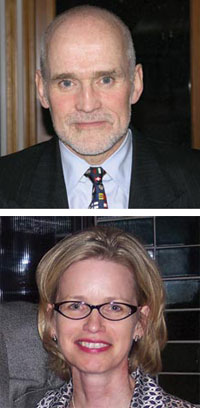Optical scientists and engineers have a lot to celebrate as Galileo’s telescope turns 400 this year and the laser turns 50 years old next year. The Optical Society of America (OSA) is serving as a partner in LaserFest, a series of events taking place in 2010 that are designed to inform the public and Washington thought leaders about the benefits of the venerated device.
This is just one example of what a professional society provides its members. Most scientists and engineers know about the benefits of poster sessions and oral presentations, the one-on-one interaction with questions answered in real time, but doubtlessly some may be unaware of the other perks of membership besides receiving information, influencing the field, and social and cultural enrichment.
 For example, OSA coordinates visits between members and legislators and between members and embassies. It lobbies world leaders to support the field of optics, primarily in the form of funding R&D, and bestows the Advocate of Optics award on those leaders who follow through on their funding promises.
For example, OSA coordinates visits between members and legislators and between members and embassies. It lobbies world leaders to support the field of optics, primarily in the form of funding R&D, and bestows the Advocate of Optics award on those leaders who follow through on their funding promises.
The 15,000 individual and 200 corporate members of OSA can subscribe to Optics and Photonics News, OSA journals, Physics Today, both in print and online, and have access to free career services and the WORKinOPTICS database, grants, award fellowships, an online research library and Optics InfoBase. OSA provides about $1 million per year in total grants funding.
“Through the OSA Foundation and other efforts by OSA, we’re able to help scientists who otherwise would not be able to afford to travel to meetings or have access to the latest journal articles,” said Liz Rogan, OSA executive director – the equivalent of CEO.

Eugene Arthurs, CEO of SPIE (top), and Liz Rogan, executive director of OSA.
Membership in SPIE has its privileges, as well. SPIE provides $380,000 each year in grants and scholarships on a competitive basis and another $40,000 as student and travel grants to its meetings, which take place all over the world.
The CEO of SPIE, Eugene Arthurs, said, “Our tax status as a 501(c)(3) not-for-profit limits the amount of lobbying we can do, but we do significant work at trying to inform decision makers in the US and EU on the importance of the work our members do.”
Educational opportunities
There is a widespread belief in the field of education that interest in science must begin at a young age. Toward this goal, the National Science Foundation (NSF)-funded Hands-On Optics program was organized by SPIE, OSA and the National Optical Astronomy Observatory. This program brings the excitement of optics to underserved communities in the US.
The local and student organizations of OSA use tools such as the Optics Discovery Kit and Hands-On Optics modules to bring optics into the classroom. The organization has a partnership with the Girl Scouts of the USA.
Arthurs emphasized that scientists have valuable knowledge. Many careers of people who majored in liberal arts or business are frustrated by an inability to understand technology, and mastery of a vital area of science is increasingly rare, he noted, adding that the importance of scientists as advisors is underscored by the actions of the current US presidential administration.
At conferences, short courses help people within the field explore new areas, and meetings and journals encourage cross-disciplinary learning.
For many people, lectures by Nobelists are a particular highlight. In the words of Arthurs, “Two Nobel laureates who impacted me substantially in recent days were the late Richard Smalley, who after winning his prize tried so hard to inspire scientists to work on the major problems facing humanity, and NASA’s John Mather, currently chief scientist on the James Webb Space Telescope, who donated a large chunk of his prize to fund a graduate student scholarship.”
SPIE’s 2009 Defense, Security and Sensing meeting featured speakers from industry and government, including Norm Augustine, former CEO of Lockheed Martin, and Jay M. Cohen, Under Secretary for Science and Technology in the Department of Homeland Security.
The OSA-sponsored CLEO 2009 event hosted Edward Moses, principal associate director for the National Ignition Facility and Photon Science Directorate at Lawrence Livermore National Laboratory. Nobel laureate and US Secretary Steven Chu made remarks at the 2009 annual OSA leadership reception.
At the helm
The leader of SPIE is a president elected by its members. However, the organization also requires extensive business management. Consider that there are 17,000 individual members and more than 500 corporate members. On top of that, some 40,000 people attend SPIE events each year, with 80,000 technical authors and 18,000 speakers. Therefore, there is a need for a CEO to control the business aspect of the organization.
Arthurs was himself a member before being selected via a search committee. “To me, my three decades of membership as someone briefly in academia but mostly in industry were extraordinarily fulfilling and, in bottom-line terms, yielded rewards much richer and more real than Madoff-type ROIs,” he said.
He credits his leadership acumen to his father and to his long experience in corporate management, yet he notes that not all productive scientists and engineers enjoy management and should not covet it. They should find an environment that recognizes a broad spectrum of contributions.
Prior to becoming the executive director of OSA, Liz Rogan served as chief operating officer and chief financial officer of the organization. She had this to say, “Leading an organization really takes a combination of things to be successful, including business-savvy, big-picture thinking, and the ability to inspire and drive new developments. Both Rogan and Arthurs cited the customer service of the organizations as a driving force in their success.